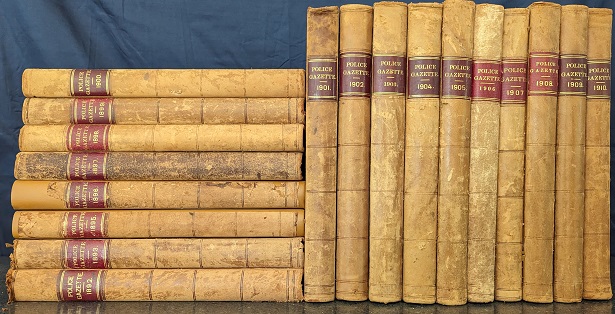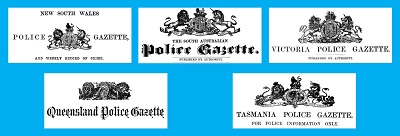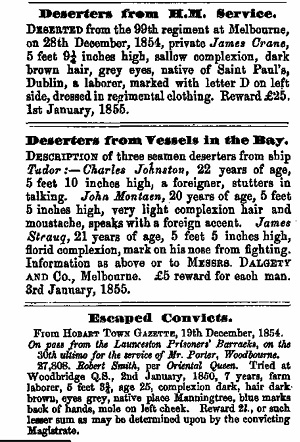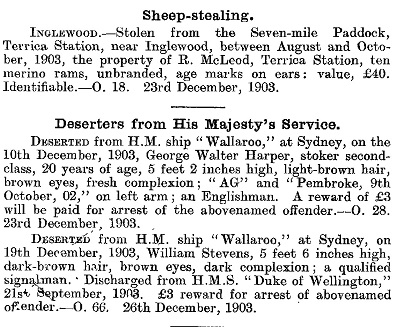
Government gazettes
Every Australian colony published regular gazettes to communicate legislation, regulations and information to the public service in particular and the community in general. Some departments such as education and police grew in size, and began their own versions. This article is about Police gazettes.
Police gazettes
Police gazettes differ from government gazettes in that they are not open to the public for some time after creation.
Police gazette commence dates - with Police restriction in brackets (period from the present they are unavailable for public use).
 New South Wales - 1862 (70 years)
New South Wales - 1862 (70 years)- Queensland - 1864 (65 years)
- South Australia - 1862 (60 years)
- Tasmania - 1861 (75 years)
- Victoria (Port Phillip) - 1851 (30 years)
- Western Australia - 1876 (50 years)
- New Zealand - 1877 (100 years)
They were compiled generally weekly in each Australian state starting from around the 1850s and 60s, as a confidential record of police activities, reports and information – for police use only. They often contain details that would not be found in the more publicly accessible government gazettes.
Information on crimes committed. One of the chief purposes of the gazette was to communicate information on crimes. Including what was committed, where it was committed, details of the victim of the crime, the details of the crime, any information or evidence gathered that may lead to the arrest of the criminal, details of the suspect or appearance of the criminal and who to contact with further information. These accounts often included names and detailed descriptions.
Information regarding criminals. This includes lists of warrants issued, arrests made, convicted people, people discharged from prison and people released on good behaviour bonds. These lists often included details of the crime, the name of the criminal, any alias’s, sex and their race, the location, sentence and terms of release. More detailed information including the appearance of the criminal including height, hair colour, eye colour, any distinguishing features, clothing, place, (including names of ships or prisons or any other relevant place) and the crime they were included in, as well as any dates and sometimes photographs.
Notice of missing persons. These are often recorded as missing family or friends, but also anyone who someone wanted to find. Information such as the missing person’s description and appearance is given, the nature of their disappearance, the time of their disappearance, their supposed destination, details of their last known or supposed whereabouts is reported when relevant.
Official police department information. Personnel change within the force. Lists of promotions, dismissals, resignations and appointments are given with information on position, place, and name. Also, appointments such as Justice of the Peace and inspectors.
Other related government department information. The police gazettes also include information on vacancies, appointments, promotions and resignations in other government departments. These include lists of Justices and court clerks etc. Notice of amendments and introductions of new acts of parliament are also given. Court lists and sessions are included.
Notice of licences (some states). Licences of various types and lists of those holding them are given in the police gazettes. These include the name, date, location for the licences.
Information from other state police gazettes. Often it was necessary for communication between states and even New Zealand regarding particular criminals, crimes, or missing persons. These are also recorded in the police gazettes, mainly regarding serious crimes or wanted people.
----------
Government and police gazettes offer great information and detail, opening up a window to our past that cannot be found anywhere else. Fascinating to browse and a vast resource of useful information!
Police gazette information
This varies, but may include the following
 Theft
Theft- Arson
- Wife or child desertion
- Pick-pocketing
- Murder
- Drunkenness
- Supplying liquor to an Aboriginal
- Wanted people – often with details such as
- age
- height
- “native of …”
- sometimes accent
- appearance
- marks (scars, tattoos)
- peculiarities
- sometimes photos (later gazettes)
- Escaped prisoners
- Military absconders
- Ship deserters
- Suspected criminals
- Licences (some states)
- tobacco sellers
- liquor sellers
- wine sellers
- auctioneers
- billiards
- hawkers
- poisons
- timber cutting
- chemists and druggists
- medical practitioners
- Police appointments
- Justices of the Peace
- Victims of crime
TIP: right click an image to open a larger view in a new tab.



Availability
Archive Digital Books Australasia (part of the Gould Genealogy group) has digitised most available years for 5 states:
- New South Wales - 1862-1938
- Queensland - 1864-1945
- South Australia - 1862-1947 (more in preparation)
- Tasmania - 1861-1933
- Victoria (Port Phillip) - 1855, 1864-1930 (more in preparation)
All these are available from Gould Genealogy in several forms
- Individual years - as ebook downloads (in the process of being converted from CD editions)
- Complete collection 1862-1938 - all available years on USB flash drive with master search of the entire collection
- FREE index to all years - the key to knowing which years are of interest to you
- Original bound printed volumes - 19 years available, mainly for NSW (until sold). These are very scarce and rarely come up for sale.


 AUD
AUD
 USD
USD
 NZD
NZD
 GBP
GBP
 Euro
Euro
